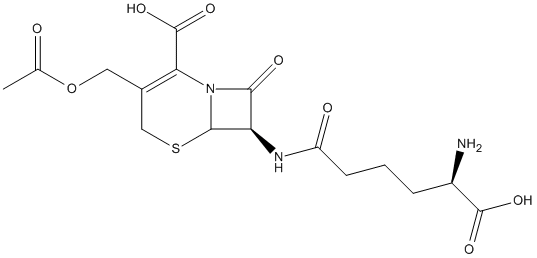Cephalosporin-C
General
Type : Natural || Antibiotic || Azabicyclo
Chemical_Nomenclature : (6R,7R)-3-(acetyloxymethyl)-7-[[(5R)-5-amino-5-carboxypentanoyl]amino]-8-oxo-5-thia-1-azabicyclo[4.2.0]oct-2-ene-2-carboxylic acid
Canonical SMILES : CC(=O)OCC1=C(N2C(C(C2=O)NC(=O)CCCC(C(=O)O)N)SC1)C(=O)O
InChI : InChI=1S\/C16H21N3O8S\/c1-7(20)27-5-8-6-28-14-11(13(22)19(14)12(8)16(25)26)18-10(21)4-2-3-9(17)15(23)24\/h9,11,14H,2-6,17H2,1H3,(H,18,21)(H,23,24)(H,25,26)\/t9-,11-,14-\/m1\/s1
InChIKey : HOKIDJSKDBPKTQ-GLXFQSAKSA-N
Other name(s) : Cephalosporin C, 7-(5-Amino-5-carboxyvaleramido)cephalosporanic acid, CHEBI:15776, UNII-3XIY7HJT5L, EINECS 200-501-6

Target
Families : Homoserine_transacetylase, Acetyl-esterase_deacetylase, BD-FAE
References (6)
| Title : The crystal structure of the cephalosporin deacetylating enzyme acetyl xylan esterase bound to paraoxon explains the low sensitivity of this serine hydrolase to organophosphate inactivation - Montoro-Garcia_2011_Biochem.J_436_321 |
| Author(s) : Montoro-Garcia S , Gil-Ortiz F , Garcia-Carmona F , Polo LM , Rubio V , Sanchez-Ferrer A |
| Ref : Biochemical Journal , 436 :321 , 2011 |
| Abstract : Montoro-Garcia_2011_Biochem.J_436_321 |
| ESTHER : Montoro-Garcia_2011_Biochem.J_436_321 |
| PubMedSearch : Montoro-Garcia_2011_Biochem.J_436_321 |
| PubMedID: 21382014 |
| Gene_locus related to this paper: bacpu-AXE |
| Title : The last step in cephalosporin C formation revealed: crystal structures of deacetylcephalosporin C acetyltransferase from Acremonium chrysogenum in complexes with reaction intermediates - Lejon_2008_J.Mol.Biol_377_935 |
| Author(s) : Lejon S , Ellis J , Valegard K |
| Ref : Journal of Molecular Biology , 377 :935 , 2008 |
| Abstract : Lejon_2008_J.Mol.Biol_377_935 |
| ESTHER : Lejon_2008_J.Mol.Biol_377_935 |
| PubMedSearch : Lejon_2008_J.Mol.Biol_377_935 |
| PubMedID: 18279889 |
| Gene_locus related to this paper: cepac-cefg |
| Title : A colorimetric assay for the determination of acetyl xylan esterase or cephalosporin C acetyl esterase activities using 7-amino cephalosporanic acid, cephalosporin C, or acetylated xylan as substrate - Martinez-Martinez_2007_Anal.Biochem_369_210 |
| Author(s) : Martinez-Martinez I , Montoro-Garcia S , Lozada-Ramirez JD , Sanchez-Ferrer A , Garcia-Carmona F |
| Ref : Analytical Biochemistry , 369 :210 , 2007 |
| Abstract : Martinez-Martinez_2007_Anal.Biochem_369_210 |
| ESTHER : Martinez-Martinez_2007_Anal.Biochem_369_210 |
| PubMedSearch : Martinez-Martinez_2007_Anal.Biochem_369_210 |
| PubMedID: 17651681 |
| Title : Batch production of deacetyl 7-aminocephalosporanic acid by immobilized cephalosporin-C deacetylase - Takimoto_2004_Appl.Microbiol.Biotechnol_65_263 |
| Author(s) : Takimoto A , Takakura T , Tani H , Yagi S , Mitsushima K |
| Ref : Applied Microbiology & Biotechnology , 65 :263 , 2004 |
| Abstract : Takimoto_2004_Appl.Microbiol.Biotechnol_65_263 |
| ESTHER : Takimoto_2004_Appl.Microbiol.Biotechnol_65_263 |
| PubMedSearch : Takimoto_2004_Appl.Microbiol.Biotechnol_65_263 |
| PubMedID: 15069587 |
| Gene_locus related to this paper: bacsu-CAH |
| Title : High-level expression, purification, and some properties of a recombinant cephalosporin-C deacetylase - Takimoto_1999_J.Biosci.Bioeng_87_456 |
| Author(s) : Takimoto A , Yagi S , Mitsushima K |
| Ref : J Biosci Bioeng , 87 :456 , 1999 |
| Abstract : Takimoto_1999_J.Biosci.Bioeng_87_456 |
| ESTHER : Takimoto_1999_J.Biosci.Bioeng_87_456 |
| PubMedSearch : Takimoto_1999_J.Biosci.Bioeng_87_456 |
| PubMedID: 16232499 |
| Gene_locus related to this paper: bacsu-CAH |
| Title : Isolation, analysis, and expression of two genes from Thermoanaerobacterium sp. strain JW\/SL YS485: a beta-xylosidase and a novel acetyl xylan esterase with cephalosporin C deacetylase activity - Lorenz_1997_J.Bacteriol_179_5436 |
| Author(s) : Lorenz WW , Wiegel J |
| Ref : Journal of Bacteriology , 179 :5436 , 1997 |
| Abstract : Lorenz_1997_J.Bacteriol_179_5436 |
| ESTHER : Lorenz_1997_J.Bacteriol_179_5436 |
| PubMedSearch : Lorenz_1997_J.Bacteriol_179_5436 |
| PubMedID: 9286998 |
| Gene_locus related to this paper: thesj-AXE1 |